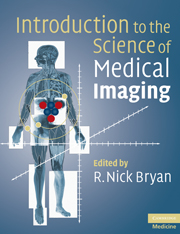Book contents
- Frontmatter
- Contents
- List of contributors
- Introduction
- Section 1 Image essentials
- Section 2 Biomedical images: signals to pictures
- Ionizing radiation
- Non-ionizing radiation
- Exogenous contrast agents
- 9 Contrast agents for x-ray and MR imaging
- 10 Nuclear molecular labeling
- Section 3 Image analysis
- Section 4 Biomedical applications
- Appendices
- Index
- References
10 - Nuclear molecular labeling
Published online by Cambridge University Press: 01 March 2011
- Frontmatter
- Contents
- List of contributors
- Introduction
- Section 1 Image essentials
- Section 2 Biomedical images: signals to pictures
- Ionizing radiation
- Non-ionizing radiation
- Exogenous contrast agents
- 9 Contrast agents for x-ray and MR imaging
- 10 Nuclear molecular labeling
- Section 3 Image analysis
- Section 4 Biomedical applications
- Appendices
- Index
- References
Summary
The tracer principle, articulated by the Hungarian chemist Georg de Hevesy (1885–1966) while in Rutherford's Manchester laboratory, remains the cornerstone of molecular imaging. de Hevesy discovered that a suitably marked small (“trace”) quantity of a compound could be used to observe the behavior of the compound in the living system. In other words, a small amount of glucose labeled with radioactive carbon can be administered to study the behavior of glucose in the body; a small amount of hyperpolarized carbon-labeled pyruvate can be administered to study pyruvate metabolism. An important feature of the principle is that the amount of tracer should be small enough not to perturb the milieu. For these insights, de Hevesy was awarded the 1943 Nobel Prize in Chemistry. In this chapter, we will focus on radioactive tracers used for evaluating biochemical processes in vivo.
Molecular labeling fundamentals
Attachment of radioactive isotopes to compounds of interest has increasing applications in nuclear medicine and modern drug discovery. There are several challenges one faces in the attachment of isotopes to molecules, including the intended final diagnostic/therapeutic application of the molecule.
Radiopharmaceuticals are radioactive compounds used for the diagnosis and treatment of many diseases, and utilized most often at very low molar concentrations that do not have pharmacologic effects on the body. Radioligand generally refers to any radiopharmaceutical that binds to a receptor on or in a cell. We will use the terms radiotracer and radioligand interchangeably to refer to radiopharmaceuticals without pharmacologic effects and used non-therapeutically.
- Type
- Chapter
- Information
- Introduction to the Science of Medical Imaging , pp. 196 - 206Publisher: Cambridge University PressPrint publication year: 2009

